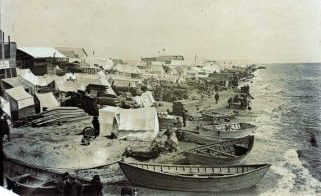

Nome Census Area AKGenWeb is a free genealogical site about the history of the area. We hope you find helpful clues for your family history research.
Are you familiar with the area? Do you have a family tree connection to the area? Volunteers are always needed! Please consider contributing your pieces of Nome Census Area family history. Corrections, updates, and additions to this site are always welcome.
Co-Coordinators:
Paleolithic peoples came into Northwestern North American 16,000 to 10,000 BC
across the Bering land bridge in Alaska.Alasks was populated by the Inuit and
some Native American peoples.Early Alaskans are divided into the following main
groups: Tlingit, Haida, Tsimshian, Athabascans, Aleut and Inupiat and Yup'ik.
The next settlers came many thousands of years later, the Russians, who came
in the fourth quarter of the 1700's for the purpose of trading furs. Some of the
traders were peaceful but many were not and spread deadly Old World diseases
which killed many off the Native populations. The Russians brought Missionaries
of the Russian Orthodox Church. Britain had a few scattered settlements on the
coast but not many. The Hudson's Bay Company had settlements at Fort Yukon, Fort
Durham and Fort Stikine.
Conditions improved for the Native Alaskans
during the mid 1800's, and their populations rebounded for most.
Russia
wanted to sell its Alaskan territory, thinking that it might be seized if war
broke out between Russia and the United Kingdom. America purchased the land,
adding 586,412 square miles of new area to the United States. The Alaska
Purchase (aka Seward's Folly) price worked out to be about two cents per acre.
The "Three Lucky Swedes" were the Discoverers of the Nome Gold Fields 23
April 1898. John Brynteson, Jafet Lindeberg and E. O. Lindblom. They were
actually two Swedes and Lindeberg was Norweigen. Their discovery was at Anvil
Creek. Nome was originally called Anvil City for that reason. Nome's name was
finally changed when it drew its name from Cape Nome which was shown on maps as
early as the 1850s.
The men found themselves embroiled in a legal battle
over their claims, because of their nationality. A corrupt Judge and illegal
claim jumpers just added to the problem. Brynteson, Lindeberg and Lindblom
persevered and their Pioneer Mining Company took in over $20 million in gold.
Two Eskimo boys, Constantine Uparazuck and Gabriel Adams, are credited with
showing them where the gold could be found.
The "Stampede to Nome"
happened in the winter of 1899-1900 after word was printed in the Klondike
Nugget June 1899 about the discovery in the Cape Nome area.Thousands came to
Nome by foot, dogsled and bicycle to search for gold.By 1900 over 20,000
prospectors arrived which was 1/3 of the white population in Alaska at that
time.
Nome Census Area AKGenWeb Copyright
Design by
Templates in Time
This page was last updated
09/27/2022